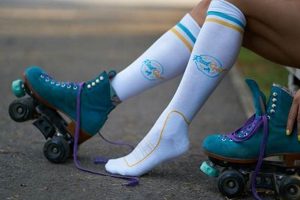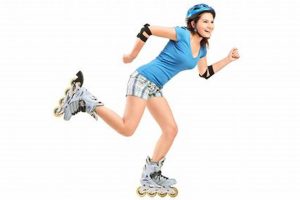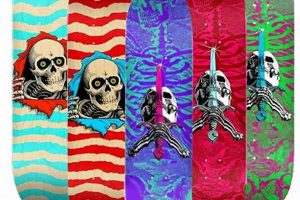These components are fundamental to the functionality of roller skates, serving as the chassis that connects the wheels to the boot. Typically constructed from materials like aluminum or nylon, they provide a stable platform for the skater. An example would be the component attached to a figure skate allowing the skater to perform spins and jumps.
Their structural integrity directly influences performance and safety. A robust, well-designed unit enhances maneuverability, responsiveness, and power transfer, allowing for greater control and efficiency. Throughout the history of roller skating, advancements in these foundational elements have continuously shaped the evolution of various skating disciplines.
Understanding the different types, materials, and adjustment mechanisms of these vital units is crucial for optimizing the skating experience. The following sections will delve deeper into these aspects, exploring the nuances that contribute to their overall performance.
Optimizing Performance Through Skate Plates
Proper selection, maintenance, and adjustment of these crucial components are paramount for maximizing performance and ensuring safety across various skating disciplines.
Tip 1: Material Selection. The material composition significantly affects weight, durability, and responsiveness. Aluminum alloys offer a balance of strength and lightness, suitable for competitive applications, while nylon options provide a more cost-effective solution for recreational use.
Tip 2: Kingpin Angle Adjustment. Altering the kingpin angle influences turning responsiveness. Steeper angles offer quicker turns, beneficial for artistic skating, while shallower angles enhance stability for speed skating.
Tip 3: Cushion Durometer. Cushion durometer affects the skate’s lean and responsiveness. Softer cushions allow for deeper leans and tighter turns, whereas harder cushions provide more stability at higher speeds.
Tip 4: Regular Inspection for Wear and Tear. Regularly inspect these components for cracks, bends, or loose hardware. Early detection of these issues can prevent potential failures and ensure user safety.
Tip 5: Proper Mounting. Correct mounting of these elements to the boot is critical for balance and power transfer. Ensure proper alignment and secure fastening to prevent instability.
Tip 6: Consistent Cleaning. Clean these components regularly to remove dirt and debris, which can impede movement and accelerate wear. Use a non-abrasive cleaner and lubricate pivot points to maintain smooth operation.
Mastering these considerations enhances both performance and longevity. Understanding these fundamental aspects allows skaters to refine their equipment and achieve their skating goals effectively.
The subsequent section will explore various types available in the market.
1. Material Composition
Material composition is a primary determinant of these component’s performance characteristics. The choice of material directly influences factors such as weight, strength, durability, and vibration absorption, subsequently impacting the skater’s control and overall skating experience. For instance, units fabricated from high-grade aluminum alloys offer an optimal strength-to-weight ratio, making them prevalent in competitive disciplines where minimizing mass and maximizing responsiveness are paramount. In contrast, composite materials, such as reinforced nylon, provide a more cost-effective and impact-resistant option suitable for recreational skating and beginner-level applications. The specific alloy or composite used dictates the unit’s ability to withstand stress, resist fatigue, and maintain structural integrity under varying load conditions.
The type of material directly correlates with the longevity and maintainability. For example, aluminum alloys are prone to corrosion in certain environments, necessitating protective coatings or regular maintenance to prevent degradation. Conversely, nylon composites exhibit inherent corrosion resistance but may be susceptible to deformation or cracking under extreme stress or prolonged exposure to ultraviolet radiation. Consider the selection of a material with high rebound, facilitating better energy transfer. This is evident in speed skating, where stiff plates made of high-performance aluminum alloys provide maximum power transfer with minimal energy loss, enabling faster acceleration and higher top speeds.
Ultimately, the material composition of these units represents a crucial design consideration. A balance between performance requirements, budget constraints, and environmental factors is essential. Understanding the properties of various materials enables skaters and manufacturers to select the most appropriate composition for their specific needs, ensuring optimal functionality, longevity, and safety. The evolution of material science continues to drive innovation, with advancements in alloy formulations and composite technologies promising enhanced performance in the future.
2. Mounting Configuration
The mounting configuration dictates how the component is affixed to the skate boot, thereby profoundly influencing the skater’s stability, control, and power transfer. This configuration primarily determines the distribution of force between the skater’s foot and the wheels. An improperly mounted component can lead to uneven weight distribution, potentially causing instability, reduced maneuverability, and even increasing the risk of injury. Precise alignment is crucial; misalignment can induce unnatural stresses on the skater’s joints and diminish the efficiency of each stride. For example, competitive figure skaters require a very specific, carefully calculated mounting configuration to optimize their balance for intricate jumps and spins. Any deviation from this optimized setup can hinder their ability to execute complex routines effectively.
Various mounting patterns exist, each offering unique advantages and disadvantages. Standard mounting positions, where the is centered beneath the boot, provide a neutral feel suitable for recreational skating and general purpose use. However, specialized mounting techniques, such as short-mount configurations, which position the component closer to the skater’s heel, enhance agility and responsiveness, favored by roller derby athletes. The selection of a suitable mounting pattern requires careful consideration of the skater’s skill level, skating style, and specific performance goals. Incorrect installation can compromise performance, resulting in energy loss and reduced control. In practical terms, proper installation involves accurately marking the boot, drilling precise holes, and securely fastening the component with appropriate hardware. A skilled technician is often required to ensure a precise and reliable connection.
In conclusion, mounting configuration forms an integral aspect of the design and functionality. Its importance stems from its direct impact on stability, control, and power transfer. Understanding and implementing correct mounting techniques are essential for maximizing performance and minimizing the risk of injury. Although often overlooked, this crucial element significantly contributes to the overall skating experience. Challenges can include adapting mounting configurations to different boot types and accurately assessing individual skater needs, highlighting the need for continued research and development in this area.
3. Kingpin Inclination
Kingpin inclination, a critical design parameter within the anatomy of these foundational units, directly influences a skate’s turning characteristics and overall maneuverability. The angle at which the kingpin is set relative to the platform dictates the responsiveness and stability experienced by the skater.
- Turning Responsiveness
Steeper kingpin angles result in quicker, more immediate turning responses. This configuration is favored by skaters requiring high agility, such as those involved in artistic skating or roller derby, where rapid directional changes are essential. The increased angle translates to a shorter lever arm, demanding less force to initiate a turn.
- Stability at Speed
Shallower kingpin angles provide enhanced stability, particularly at higher speeds. This arrangement is typically preferred in speed skating disciplines, where maintaining a straight line and minimizing unwanted directional deviations are critical for maximizing efficiency and velocity. The reduced angle contributes to a longer lever arm, requiring more force to initiate a turn, thereby increasing stability.
- Cushion Compression Dynamics
Kingpin inclination affects the compression of the cushions (or bushings) that mediate the turning action. Steeper angles compress the cushions more rapidly, leading to a snappier feel, while shallower angles provide a more gradual compression, offering a smoother and more controlled response. The durometer (hardness) of the cushions must be carefully selected in conjunction with the kingpin angle to achieve the desired balance of responsiveness and stability.
- Influence on Pivot Point Geometry
The kingpin angle plays a vital role in defining the virtual pivot point around which the skate rotates during a turn. Altering the inclination shifts the location of this pivot point, affecting the skater’s balance and the distribution of force across the wheels. An optimal pivot point position enhances control and reduces the risk of wheel slippage during sharp turns.
In summary, kingpin inclination is a fundamental factor influencing the handling characteristics of these essential skating components. Its careful adjustment allows skaters to tailor their equipment to suit specific skating styles and performance requirements. Varying the inclination affects turning speed, stability, cushion compression, and pivot geometry. This underscores the importance of understanding and properly adjusting kingpin inclination for achieving optimal skating performance and control.
4. Cushion Durometer
Cushion durometer, a measure of hardness, profoundly affects the performance characteristics of the overall skating system. These cushions, typically composed of polyurethane, sit between the component and the kingpin, acting as the primary suspension system. The durometer dictates the resistance to compression, thus influencing the skate’s lean, responsiveness, and stability. A lower durometer indicates a softer cushion, allowing for deeper lean and tighter turns, making it suitable for artistic skating or roller derby where maneuverability is paramount. Conversely, a higher durometer signifies a harder cushion, providing greater stability and control, often favored by speed skaters seeking to minimize unwanted movement at high velocities. The durometer, therefore, is not a trivial element but an integral component affecting the entire kinetic profile.
The interplay between cushion durometer and the structural attributes of the units impacts the skater’s experience. For instance, a unit constructed from a highly rigid material, such as aircraft-grade aluminum, will transmit more energy to the cushions, amplifying the effect of the durometer. A skater using stiff plates will notice a greater difference between a soft and hard cushion compared to a skater using a plate constructed from a more flexible composite material. This connection influences customization; skaters often experiment with different durometers to fine-tune their equipment to match their skating style, body weight, and the specific demands of their discipline. A heavier skater, for example, may require a higher durometer to prevent excessive compression and maintain stability. Adjustments require an understanding of the cause-and-effect relationship between durometer and the overall performance.
Understanding the connection between cushion durometer and the essential components allows skaters to optimize their equipment for specific performance goals. Challenges arise from the subjective nature of feel and the complex interaction between various skate components. It’s essential to consider durometer in conjunction with other factors like kingpin angle, wheel hardness, and boot stiffness. Careful experimentation and iterative adjustments are often necessary to achieve the desired balance of responsiveness and stability, enhancing performance and mitigating the risk of injury. A holistic approach ensures that these fundamental pieces work together in harmony, leading to an optimal skating experience.
5. Pivot Cup Integrity
Pivot cup integrity directly influences the operational efficiency of essential skating components. These small, often overlooked, components facilitate smooth and controlled turning action by providing a low-friction interface between the kingpin and the element. Their condition significantly impacts the overall responsiveness and stability of the skate.
- Material Degradation and Wear
Pivot cups are typically constructed from polyurethane or similar polymeric materials. Over time, these materials can degrade due to friction, pressure, and exposure to environmental factors such as UV radiation and temperature fluctuations. Wear can lead to dimensional changes, increased friction, and ultimately, compromised turning performance. Failure to replace worn cups results in imprecise handling and potential instability.
- Influence on Kingpin Movement
Intact pivot cups ensure smooth and unrestricted kingpin movement within the skating unit. Damaged or deformed cups can impede this movement, causing a “sticky” or inconsistent turning response. This can negatively impact the skater’s ability to execute precise maneuvers and maintain balance, especially during high-speed or technical skating.
- Impact on Overall Stability
The pivot cup contributes to the overall stability of the roller skate. Worn cups allow for excessive play in the system, leading to a less predictable and controlled skating experience. By providing a stable base for the kingpin, they minimize unwanted vibrations and oscillations, enabling skaters to maintain a steady platform.
- Importance of Material Selection
The material from which a pivot cup is constructed greatly influences its lifespan and performance characteristics. High-quality polyurethane compounds offer superior resistance to wear, tear, and environmental degradation compared to lower-grade materials. Selecting cups made from appropriate compounds maximizes longevity and ensures consistent performance.
Maintaining pivot cup integrity is paramount for preserving the performance and safety of any skating system. Regular inspection and timely replacement of worn or damaged cups prevent degradation in handling. Proper care and the use of quality components is essential for maximizing the lifespan. Neglecting pivot cup maintenance compromises the functionality and negatively affects the overall skating experience.
Frequently Asked Questions About Skate Plates
The following questions address common inquiries regarding the selection, maintenance, and functionality of these crucial components in roller skates.
Question 1: What are the primary materials used in the construction of skate plates, and how do these materials affect performance?
These components are generally manufactured using aluminum alloys, composite polymers (nylon), or a combination thereof. Aluminum offers superior strength-to-weight ratio, enhancing responsiveness and control, while composite materials provide cost-effectiveness and impact resistance. Material selection significantly influences durability and overall skating experience.
Question 2: How does the kingpin angle on impact turning responsiveness and stability?
A steeper kingpin angle facilitates quicker, tighter turns, favored in artistic and roller derby disciplines. Conversely, a shallower angle promotes stability at higher speeds, making it preferable for speed skating. Altering the kingpin angle influences the force required to initiate turns, directly affecting maneuverability.
Question 3: What is the significance of cushion durometer, and how should it be chosen?
Cushion durometer, a measure of hardness, affects the skate’s lean and overall responsiveness. Softer cushions (lower durometer) allow for deeper leans, whereas harder cushions (higher durometer) provide greater stability. Selection depends on skater weight, skating style, and desired level of control.
Question 4: What are the key considerations when mounting components to a skate boot?
Proper alignment is crucial for balance and power transfer. Incorrect mounting can lead to instability, reduced maneuverability, and increased risk of injury. The mounting position must be carefully selected based on skating style and individual biomechanics.
Question 5: How frequently should elements be inspected and maintained?
Regular inspection is recommended before each skating session to identify potential cracks, bends, or loose hardware. Cleaning should be performed periodically to remove dirt and debris. Timely maintenance ensures optimal performance and prolongs the lifespan of these components.
Question 6: Are compatible with all types of skate boots?
Not all units are universally compatible. Boot compatibility depends on factors such as mounting patterns, boot shape, and intended use. Consulting manufacturer specifications and seeking professional advice are essential for ensuring proper fit and functionality.
The information provided addresses prevalent concerns regarding the functional role of these components, thereby enabling informed decisions pertaining to their choice and management.
The subsequent section will provide a comparison of some commercially available products.
Concluding Remarks on Skate Plates
This exploration has detailed the critical role of these foundational units in roller skating. Key aspects, including material composition, mounting configuration, kingpin inclination, cushion durometer, and pivot cup integrity, have been thoroughly examined. These elements collectively define performance characteristics, impacting maneuverability, stability, and power transfer across diverse skating disciplines.
Continued innovation in materials, design, and customization promises to further refine performance. As skating technology evolves, a deeper understanding of these components remains paramount. Investigate and comprehend these technologies will lead to safer, more efficient, and personalized skating experiences.







